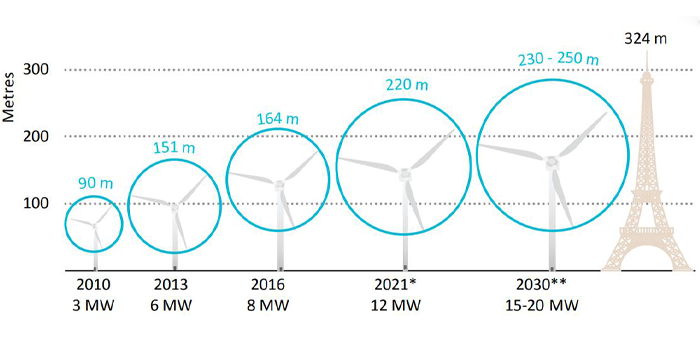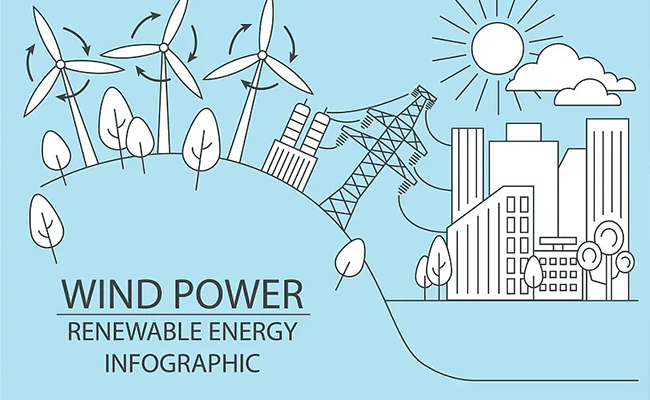The principle of wind turbines
As the wind interacts with the wind rotor, it sets the rotor blades in motion, kickstarting rotation to harness average wind turbine power. The transmission device accelerates the rotor to the generator’s required speed. The main shaft rotation drives the generator’s rotor, inducing current through wire-magnetic field interaction. Copper winding rotation within the magnetic field generates electricity in the generator, which is subsequently transmitted to the power grid via the transmission device, optimizing average wind turbine power utilization.

How many degrees of electricity can a wind turbine generate in one rotation?
Calculation formula: Power generation (kWh) = wind rotor area (m²) × wind speed (m/s)³ × power factor. This formula is derived based on the basic principles of wind energy and the actual situation of wind power generation. Among them, the power factor is a parameter that reflects the efficiency of wind energy extraction, and is usually between 0.35 and 0.45.
Example analysis
Case Analysis
Case 1: Take a 1.5MW wind turbine as an example. According to Goldwind Technology’s data, the rated power of the unit is 1580kW. Under full load, that is, when the wind speed reaches the rated speed, the wind turbine can generate 1500 kWh of electricity per hour. If 17.3 revolutions/minute is used as the reference value of the rated speed, the amount of electricity generated by the wind turbine in one revolution under full load is calculated as follows:
Single-circle power generation = 1500kW/h60×17.3≈5.36kW/h
This means that under ideal full load conditions, the wind turbine can generate about 5.36 kWh of electricity in one revolution.
Case 2: A 2MW direct-drive wind turbine can generate 2000 kWh of electricity every 60 minutes when the wind energy is sufficient and stable. It takes 3.5 seconds for the fan blades to rotate once, so the amount of electricity generated per second is:
Electricity per second = 2000kWh/3600s≈0.56kWh per second
Then the amount of electricity generated by the fan of the wind turbine for each rotation is:
Single-turn electricity = 0.56kWh/s×3.5s≈1.96kWh
The case analyses reveal that a wind turbine’s electricity generation per rotation is impacted by factors like wind speed, rotor design, and generator efficiency, leading to potential variations in output based on environmental conditions and equipment performance.
Electricity generation of the world’s first 16MW offshore wind turbine
The world’s first 16MW offshore wind turbine, located at the Fujian offshore wind farm, has a hub center height of 152 meters and a rotor sweep area equivalent to 7 standard football fields. This turbine can produce 34.2 kWh of electricity per rotation under rated conditions. A single unit can generate over 66 million kWh of clean electricity annually, fulfilling the yearly electricity requirements of 36,000 families of three.
Factors affecting the power generation of wind turbines
(I) Wind speed
Wind speed has a crucial impact on the power generation of wind turbines. During low wind speeds, the rotor blades of a wind turbine struggle to gather enough kinetic energy to power the generator effectively. Conversely, when wind speeds are excessively high, the turbine faces challenges. If the wind speed surpasses the turbine’s limit, it ceases operation to prevent damage. Excessive speeds increase eccentricity, disrupt the turbine’s balance, and raise the risk of blade breakage.
(II) Blade speed
Blade speed correlates with power generation, yet power generation isn’t contingent on blade speed. Wind turbine generators include a gearbox-like device ensuring a relatively constant and low speed input to the generator regardless of blade speed.
With constant blade speed, blade force and power increase. For instance, a 1.5 MW turbine generates 1500 kWh per hour at full power. This illustrates that larger turbine blades yield greater power output.
(III) Number of blades
The number of blades has an impact on the power generation of wind turbines. Generally speaking, 3 blades are more efficient than 4 blades. For wind turbines, multiple blades offer higher torque conversion rates. However, in terms of energy conversion efficiency, 4-blade and 5-blade turbines are less efficient than 3-blade turbines.
Due to the large resistance, multi-blade wind turbines will produce adverse factors that interfere with the rotation of the blades and reduce the energy conversion rate. At the same time, 3 blades make it easier for the wind turbine to maintain balance. When the number of blades is too large, it is more difficult to balance the wind turbine and the cost is high.
Although the speed of a two-blade wind turbine may be higher than that of a three-blade fan, it will generate a lot of noise due to the faster speed, and it will require stronger force to resist the increased centrifugal force, which will also increase the cost. In addition, the wind capture efficiency of a two-blade fan is not as good as that of a three-blade fan. Therefore, considering all factors, three blades are the ideal design for a wind turbine.
Each type of fan has a maximum speed. When the wind speed is too fast, the background operation computer needs to stop the fan to reduce the damage and wear caused by its own inertia.
When wind speed exceeds limits, the computer halts fans to prevent damage. Average wind turbine power isn’t tied to blade speed; consistent rotation boosts force and power. Larger blades yield higher power output, enhancing average wind turbine power generation.

